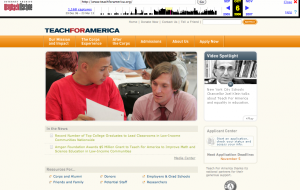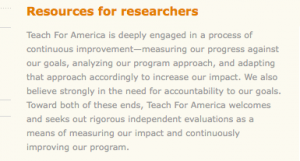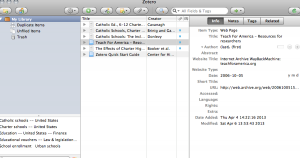#15 In Taylor Godfrey’s 2012 web essay, she bases her claims on content that appeared on the Teach for America website over six years ago, yet does not mention how she found this source. Describe how she did it, and offer a better citation. (Hint: See an amazing tool provided by the Internet Archive.)
My source detection assignment for this week allowed me to do some interesting digging around the Internet. I began my search by referring to Taylor Godfrey’s essay, which can be found under our assigned reading for April 7th. That was the easy part. After opening up the web essay, I immediately saw the “content” that the question was asking me to expand on. At the top of the page she prefaces her essay with the quote, “Teach for America Welcomes and seeks out rigorous independent evaluations as a means of measuring our impact and continuously improving our program.” She goes on to explain that this was taken from the Teach For America website six years ago, on October 5th, 2006. Interesting, but where was her citation? Taylor wrote a compelling and well-researched essay on how Teach For America (TFA) has evolved over the past six years, yet she left out how she found this source. Without a proper citation, how will future readers know where she got her information, and whether it is valid or trustworthy? In order to properly address my detection question, I had to start from the beginning and retrace Taylor’s steps when she referred to the TFA website, only this time I would be sure to properly cite the source used.
To tackle this somewhat daunting task, I decided to turn to the page of search strategies for sources that we reviewed last week in class, with my eyes peeled for one database in particular—the Internet Archive. With one quick click (thanks Jack!) I was directed to the Internet Archive’s page, an amazing Internet resource that is a nonprofit, free, and open for public use. I focused in on the WayBackMachine, and entered TFA’s url, teachforamerica.org.

I was brought to a page that featured years going all the way back to 1996, but didn’t stay long out of fear of becoming too overwhelmed. I clicked on the year 2006, and scrolled down to the month of October, and then found what day I was looking for, the 5th. With one more simple click, I was transported back in time to the TFA website looked like seven years ago.

Now, however, things were getting a little more complicated. Where had Taylor found this specific quote? I had to do some searching of my own, and was impressed with how much of the TFA website had been archived. I browsed around the site, clicking on various links hoping to find out where Taylor had found her information. I finally found a resource directed at “researchers” in the bottom part of the homepage, and struck gold. The first paragraph had the exact information I had been looking for.

I’d found the quote, but now what? I directed myself back to what my source detection question was asking, and have to admit that I was a little bit confused and felt myself approaching a stopping point. I decided to close my computer for the time being, and made an appointment with Jack for the following day just to check-in and make sure I was on the right track.
The meeting was exactly what I needed. With the help of Jack and Zotero, I was able to provide the final part of the answer my source detection question was asking for. I’d found the webpage, and now just had to provide a better citation for the quote that Taylor based her web essay on. I’d never used Zotero to cite a webpage before, but found it easy and efficient. Zotero automatically had the item type, title, date, date added, and date modified sections filled out, so all I had to do was input the website title and URL link.

So, after all of this work and digging through the Internet archives, I have concluded that the better citation Taylor should have used in her web page is:
“Teach For America – Resources for Researchers.” Internet Archive WayBackMachine, October 5, 2006. http://web.archive.org/web/20061005151645/http://www.teachforamerica.org/research/index.htm.
A richly detailed post on the wonders of the WayBack machine, with an extra lesson on using Zotero to help create a more meaningful citation. Very helpful for future readers.